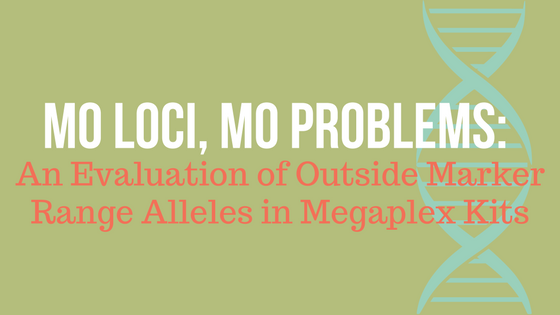The expanded set of loci in megaplex kits facilitate increased confidence in database matches. However, with the addition of more loci in a limited number of dye channels and smaller amplicons comes new concerns. Our laboratory has observed a number of alleles that are designated as outside marker range (OMR) or appear to fall into the marker range of adjacent loci. These alleles are often denoted as tri-alleles in the adjacent locus, but can also appear as a heterozygote, usually with poor peak height balance. This problem does not appear to be limited to a single megaplex amplification system.
written by: Amanda hahn, state of wisconsin department of justice
In a preliminary study using Fusion® 6C and Fusion® amplification kits, the Wisconsin DNA Databank observed instances of alleles designated as outside marker range or appearing to fall into the marker range of adjacent loci in approximately 0.1% of offender DNA profiles. Further analysis revealed that D1S1656, D2S441, D10S1248, and D12S391 were most frequently impacted using these amplification kits.
Based on self-reported information, it appears that many of these specific alleles are observed in non-European populations (e.g. Native American, African American). Additionally, although the order of many loci are unchanged between Fusion® 6C and Fusion®, differences in the initial allele designation were observed, which can likely be attributed to variation in spacing between loci.
Alleles inadvertently designated into the adjacent, incorrect locus may increase the complexity of profile comparisons with different amplification kits, have an impact on statistical analysis and CODIS eligibility, or create the potential for missed matches in CODIS.
Our laboratory has observed a few situations that have resulted in procedure modifications to minimize genotype errors. In a two person mixture sample, the laboratory observed a situation where an outside marker range allele from D2S441 was attributable to the major contributor genotype in D1S1656 when the true genotype of the major contributor genotype was actually a homozygote. Based on peak height ratios, the outside marker range allele could have paired with the major allele in D1S1656 or D2S441. While this incorrect genotype designation did not impact the conclusion because the buccal standard was amplified in the same amplification kit and the change in statistical analysis of the major contributor was minimal, this type of error could have a significant impact on a partial profile or mixture profile statistical analysis.
Because many different amplification systems are used for the generation of DNA profiles for entry into the Combined DNA Index System (CODIS), our laboratory has chosen to enter offender DNA profiles to incorporate both possible iterations of the DNA profile. Most of the amplification kits will have loci in a different order so it may be possible to identify the correct locus for an outside marker allele utilizing multiple amplification systems. Our analysts have been instructed to closely evaluate CODIS matches when there appears to be an outside marker range allele involved so that a true match is not missed due to the use of different amplification systems. Additionally, for the analysis of offender DNA profiles, the GeneMapper® ID-X expert system minimum heterozygote peak height ratio PQV was increased to ensure analyst evaluation of possible outside marker range alleles.
WOULD YOU LIKE TO SEE MORE ARTICLES LIKE THIS? SUBSCRIBE TO THE ISHI BLOG BELOW!


